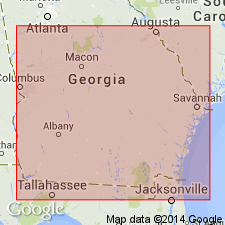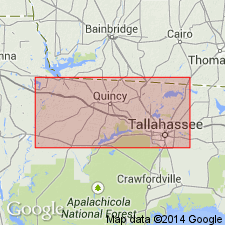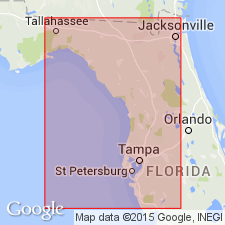
- Usage in publication:
-
- Dogtown Clay Member
- Modifications:
-
- Named
- Dominant lithology:
-
- Clay
- Sand
- Limestone
- Dolostone
- AAPG geologic province:
-
- South GA-North FL sedimentary province
Summary:
Dogtown Clay Member, a clay-rich interval in the upper Torreya Formation of the Hawthorne Group, is here named in north-central FL. Name was informally introduced in an abstract by Huddlestun and Hunter (1982: Florida Bur. Geol. Spec. Pub. 25). Unit includes fuller's earth beds, but only in Gadsden Co., FL, and Decatur Co., GA, are they of commercial grade. Though the unit is primarily clay, subordinate lithic components include quartz sand, limestone, and dolostone. Palygorskite and montmorillonite are characteristic clay minerals. Bedding varies from blocky, massive, and structureless through massive, burrowed, and bioturbated to thinly layered, laminated, and fissile. Dogtown appears to be restricted to the interior of the Apalachicola Embayment in FL, and the southern part of the Gulf Trough and flanks in GA. Member is present in northern Liberty, Gadsden, and Leon Cos., FL, and southern Decatur and Grady Cos., GA. Gradationally overlies the Sopchoppy Member; conformably underlies calcareous sediments of the undifferentiated Torreya or disconformably underlies the Miccosukee or Jackson Bluff Formations. Thickness at the type section is about 27 ft (8 m) and ranges from 15.5 ft to 40.5 ft. Environment of deposition interpreted as marine, very near shore, and brackish to hypersaline. Age is assumed to be the same as the rest of the Torreya--early Miocene (early to middle Burdigalian).
Source: GNU records (USGS DDS-6; Reston GNULEX).

- Usage in publication:
-
- Dogtown Member
- Modifications:
-
- Age modified
- Biostratigraphic dating
- Geochronologic dating
- AAPG geologic province:
-
- Florida platform
Summary:
Dogtown Member of the upper Torreya Formation of Hawthorn Group in northern Gadsden Co., FL, contains an early Barstovian land mammal fauna and has 87Sr/86Sr age estimates between 16.6+/-1.0 and 14.7+/-1.5 Ma. These, together with reversed magnetic polarity constrain the age of the unit in the study area to between 15.9 and 15.3 Ma. Evidence from a second fossil locality indicates that the Dogtown is time transgressive--younger to the north.
Source: GNU records (USGS DDS-6; Reston GNULEX).

- Usage in publication:
-
- Dogtown Member
- Modifications:
-
- Biostratigraphic dating
- AAPG geologic province:
-
- Florida platform
Summary:
Three of the five early Miocene (Hemingfordian) land mammal sites in FL occur in the Torreya Formation in the eastern panhandle. The late Hemingfordian Midway Local Fauna was collected from the Dogtown Member in the upper Torreya of Gadsden Co. and indicates a late early Miocene, late Burdigalian (18-16.5 Ma) age. The Willacoochee Creek Fauna, collected from the top of the Dogtown Member, is early Barstovian in age (early middle Miocene, Langhian, 16-15 Ma. This correlates with the upper part of the Arcadia Formation in the southern peninsula.
Source: GNU records (USGS DDS-6; Reston GNULEX).
For more information, please contact Nancy Stamm, Geologic Names Committee Secretary.
Asterisk (*) indicates published by U.S. Geological Survey authors.
"No current usage" (†) implies that a name has been abandoned or has fallen into disuse. Former usage and, if known, replacement name given in parentheses ( ).
Slash (/) indicates name conflicts with nomenclatural guidelines (CSN, 1933; ACSN, 1961, 1970; NACSN, 1983, 2005, 2021). May be explained within brackets ([ ]).

